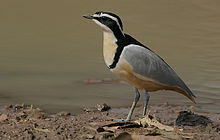| Egyptian plover | |
|---|---|

| |
| Kaur Wetlands, the Gambia | |
| Scientific classification | |
| Domain: | Eukaryota |
| Kingdom: | Animalia |
| Phylum: | Chordata |
| Class: | Aves |
| Order: | Charadriiformes |
| Family: | Pluvianidae Reichenbach, 1848 |
| Genus: | Pluvianus Vieillot, 1816 |
| Species: | P. aegyptius
|
| Binomial name | |
| Pluvianus aegyptius | |

| |
| Range | |
| Synonyms | |
|
Charadrius aegyptius Linnaeus, 1758 | |

The Egyptian plover (Pluvianus aegyptius), also known as the crocodile bird, is a wader, the only member of the genus Pluvianus. It occurs in a band across Sub-Saharan Africa from Senegal in the west to Ethiopia in the east and south to parts of the Democratic Republic of the Congo. It no longer occurs in Egypt. The species was formerly placed with the pratincoles and coursers in the family, Glareolidae, but is now regarded as the sole member of its own monotypic family Pluvianidae.
The species is one of several plovers doubtfully associated with the "trochilus" bird mentioned by the Greek historian Herodotus in a supposed cleaning symbiosis with the Nile crocodile.
- ^ BirdLife International (2016). "Pluvianus aegyptius". IUCN Red List of Threatened Species. 2016: e.T22694086A93437931. doi:10.2305/IUCN.UK.2016-3.RLTS.T22694086A93437931.en. Retrieved 11 November 2021.
